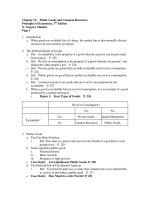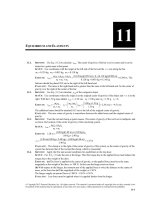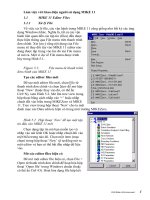VSICM6 m11 vsphereupdatemanager
Bạn đang xem bản rút gọn của tài liệu. Xem và tải ngay bản đầy đủ của tài liệu tại đây (671.69 KB, 31 trang )
vSphere Update Manager and Host Maintenance
Module 11
© 2015 VMware Inc. All rights reserved.
You Are Here
1. Course Introduction
7. Virtual Machine Management
2. Software-Defined Data Center
8. Resource Management and
3. Creating Virtual Machines
4. vCenter Server
5. Configuring and Managing
Virtual Networks
6. Configuring and Managing
Virtual Storage
Monitoring
9. vSphere HA and vSphere Fault
Tolerance
10. Host Scalability
11. vSphere Update Manager and
Host Maintenance
12. Installing vSphere Components
VMware vSphere: Install, Configure, Manage
© 2015 VMware Inc. All rights reserved.
11-2
Importance
Over time, your VMware vSphere® environment might undergo changes
in its hardware or software configuration, or in the form of software
updates or patches.
From a manageability and scalability perspective, you should implement
changes to your vSphere environment in an orderly, controlled, and
systematic fashion.
VMware vSphere: Install, Configure, Manage
© 2015 VMware Inc. All rights reserved.
11-3
Module Lessons
Lesson 1: Introducing vSphere Update Manager and Patch
Management
Lesson 2:
Host Profiles
VMware vSphere: Install, Configure, Manage
© 2015 VMware Inc. All rights reserved.
11-4
Lesson 1:
Introducing vSphere Update
Manager and Patch Management
11-5
© 2015 VMware Inc. All rights reserved.
Learner Objectives
By the end of this lesson, you should be able to meet the following
objectives:
ã Describe VMware vSpheređ Update Manager functionality
• List the steps to install vSphere Update Manager
• Use vSphere Update Manager create and attach a baseline
VMware vSphere: Install, Configure, Manage
© 2015 VMware Inc. All rights reserved.
11-6
About vSphere Update Manager
vSphere Update Manager enables centralized, automated patch and
version management for VMware ESXi™ hosts, virtual machine
hardware, VMware Tools™, and virtual appliances.
vSphere Update Manager reduces security risks:
• Reduces the number of vulnerabilities.
• Eliminates many security breaches that exploit older vulnerabilities.
vSphere Update Manager reduces the diversity of systems in an
environment:
• Makes management easier.
• Reduces security risks.
vSphere Update Manager keeps machines running more smoothly:
• Patches include bug fixes.
• Makes troubleshooting easier.
VMware vSphere: Install, Configure, Manage
© 2015 VMware Inc. All rights reserved.
11-7
vSphere Update Manager Capabilities
vSphere Update Manager enables cross-platform upgrade from VMware
ESXđ to ESXi.
Automated patch downloading:
ã Begins with information-only downloading.
ã Is scheduled at regular configurable intervals.
Creation of baselines and baseline groups
Scanning:
• Inventory systems are scanned for baseline compliance.
Remediation:
• Inventory systems that are not compliant can be automatically patched.
Reduces the number of reboots required after VMware Tools updates
VMware vSphere: Install, Configure, Manage
© 2015 VMware Inc. All rights reserved.
11-8
vSphere Update Manager Components
vSphere Update Manager includes several components and requires
network connectivity with VMware vCenter Server™.
vSphere Update Manager server component:
• Install on the same computer as Windows vCenter Server or on a different
computer.
Client components:
• vSphere Update Manager Client runs on the desktop:
– Use the vSphere Update Manager Client to perform patch and version management
of the vSphere inventory.
• Update Manager tab in the VMware vSphere® Web Client plug-in:
– Use to view scan results and compliance states for vSphere inventory objects.
Database:
• Use to store and organize server data.
VMware vSphere: Install, Configure, Manage
© 2015 VMware Inc. All rights reserved.
11-9
Requirements for Installing vSphere Update Manager
vSphere Update Manager has the following installation requirements:
• vSphere Update Manager must be installed on a Windows 64-bit machine.
• The vSphere Update Manager server requires an SQL Server or an Oracle
database.
• vCenter Server must be installed.
• Update Manager 6 is compatible only with vCenter Server 6.
You can install the vSphere Update Manager server and vSphere
Update Manager Client only on Windows machines.
VMware vSphere: Install, Configure, Manage
© 2015 VMware Inc. All rights reserved.
11-10
Installing vSphere Update Manager
To use vSphere Update Manager, you must ensure that your vCenter
Server 6 is already installed, and complete the following tasks:
1.
Create and prepare a database.
2.
Install the vSphere Update Manager server.
3.
Install the vSphere Update Manager Client.
4.
Enable the vSphere Update Manager plug-in for the vSphere Web
Client.
VMware vSphere: Install, Configure, Manage
© 2015 VMware Inc. All rights reserved.
11-11
Configuring vSphere Update Manager Settings
You can modify the vSphere Update Manager configuration only if you
have the correct privileges:
• Network Connectivity Settings
• Download Settings
• Proxy Settings
• Checking for Updates (Download Schedule) Settings
• Notification Check Schedule Settings
• Virtual Machine Settings
• Host and Cluster Settings
VMware vSphere: Install, Configure, Manage
© 2015 VMware Inc. All rights reserved.
11-12
Baseline and Baseline Groups
A baseline consists of one or more patches, extensions, or upgrades:
• vSphere Update Manager includes two default dynamic patch baselines and
three upgrade baselines.
A baseline group consists of multiple baselines:
• Can contain one upgrade baseline per type and one or more patch and
extension baselines.
VMware vSphere: Install, Configure, Manage
© 2015 VMware Inc. All rights reserved.
11-13
Creating and Editing Patch or Extension Baselines
You can create custom patches, extensions, and upgrade baselines to
meet the needs of your specific deployment by using the New Baseline
wizard:
• Create a fixed patch baseline:
– Fixed baselines consist of a set of patches that do not change as patch availability
changes.
• Create a dynamic patch baseline:
– Dynamic baselines consist of a set of patches that meet certain criteria.
• Create a host extension baseline:
– Extension baselines contain additional software for ESXi hosts. This additional
software might be VMware software or third-party software.
• Filter patches or extensions in the New Baseline wizard:
– When you create a patch or extension baseline, you can filter the patches and
extensions available in the vSphere Update Manager repository to find specific
patches and extensions to exclude or include in the baseline.
VMware vSphere: Install, Configure, Manage
© 2015 VMware Inc. All rights reserved.
11-14
Attaching a Baseline
To view compliance information and scan objects in the inventory against
baselines and baseline groups, you must first attach baselines and
baseline groups to these objects.
You can attach baselines and baseline groups to objects in the vSphere
Update Manager plug-in to the vSphere Web Client: the Update
Manager tab.
VMware vSphere: Install, Configure, Manage
© 2015 VMware Inc. All rights reserved.
11-15
Scanning for Updates
Scanning evaluates the inventory object against the baseline or baseline
group.
VMware vSphere: Install, Configure, Manage
© 2015 VMware Inc. All rights reserved.
11-16
Viewing Compliance for vSphere Objects
You can review compliance information for the virtual machines, virtual
appliances, and hosts against baselines and baseline groups that you
attach.
VMware vSphere: Install, Configure, Manage
© 2015 VMware Inc. All rights reserved.
11-17
Remediating Objects
You can remediate virtual machines, templates, virtual appliances, and
hosts:
• You can perform the remediation immediately or schedule it for a later date.
• Host remediation runs in different ways, depending on the types of baselines
that you attach and whether the host is in a cluster or not.
• For ESXi hosts in a cluster, the remediation process is sequential by default.
• Remediation of hosts in a cluster requires that you temporarily disable cluster
features such as VMware vSphere® Distributed Power Management™ and
VMware vSpheređ High Availability admission control.
VMware vSphere: Install, Configure, Manage
â 2015 VMware Inc. All rights reserved.
11-18
Patch Recall Notification
At regular intervals, vSphere Update Manager contacts VMware to
download notifications about patch recalls, new fixes, and alerts:
• Notification Check Schedule is selected by default.
On receiving patch recall notifications, vSphere Update Manager takes
the following actions:
• Generates a notification in the notification tab
• No longer applies the recalled patch to any host:
– Patch is flagged as recalled in the database.
• Deletes the patch binaries from its patch repository
vSphere Update Manager does not uninstall recalled patches from ESXi
hosts. It waits for a newer patch and applies that patch to make a host
compliant.
VMware vSphere: Install, Configure, Manage
© 2015 VMware Inc. All rights reserved.
11-19
Lab 23: Using vSphere Update Manager
Install, configure, and use vSphere Update Manager
• Install the vSphere Update Manager Server
• Install vSphere Update Manager
• Modify the Cluster Settings
• Configure vSphere Update Manager
• Create a Patch Baseline
• Attach a Baseline and Scan for Updates
• Stage the Patches onto the ESXi Hosts
• Remediate the ESXi Hosts
VMware vSphere: Install, Configure, Manage
© 2015 VMware Inc. All rights reserved.
11-20
Review of Learner Objectives
You should be able to meet the following objectives:
ã Describe VMware vSpheređ Update Manager functionality
ã List the steps to install vSphere Update Manager
• Use vSphere Update Manager create and attach a baseline
VMware vSphere: Install, Configure, Manage
© 2015 VMware Inc. All rights reserved.
11-21
Lesson 2:
Host Profiles
11-22
© 2015 VMware Inc. All rights reserved.
Learner Objectives
By the end of this lesson, you should be able to meet the following
objectives:
• Describe the host profiles workflow
• Identify how to create a host profile
• Recognize how to apply a host profile to an ESXi host or cluster
• Use host profiles to perform remediation on an ESXi host
VMware vSphere: Install, Configure, Manage
© 2015 VMware Inc. All rights reserved.
11-23
About Host Profiles
Host profiles provide an automated and centrally managed mechanism
for host configuration and configuration compliance.
VMware vSphere: Install, Configure, Manage
© 2015 VMware Inc. All rights reserved.
11-24
Host Profiles Workflow
The host profile workflow starts with the concept of a reference host. The
reference host serves as the template from which the host profile is
extracted:
1.
Set up and configure the reference host.
2.
Create a host profile from the reference host.
3.
Attach other hosts or clusters to the host profile.
4.
Check the compliance of the added hosts to the host profile. If all
hosts are compliant with the reference host, they are correctly
configured.
5.
Apply the resulting recommendations to the hosts.
VMware vSphere: Install, Configure, Manage
© 2015 VMware Inc. All rights reserved.
11-25









